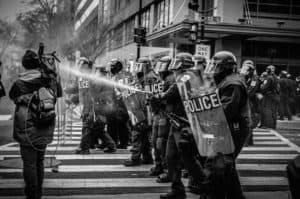Claims for Excessive Force and Police Brutality
In our last post in this series on civil rights cases, we provided a general overview of the federal statute that creates a cause of action known as a “1983 claim”, as well as a brief introduction on who such claims may be brought against. Recall that claims may be brought against individuals acting on behalf of the government under color of law (“state actors”), as well as cities, counties, and municipalities for the conduct of their employees, and in the rarer circumstances, against a city or county that has an unconstitutional policy that is the moving force behind a constitutional violation.
In the next few posts, we will provide an overview of some of the more common civil rights claims made by individuals against the police and local governments. These upcoming posts are not intended as a comprehensive listing of all civil rights claims available at law, rather, they are intended to provide basic information relevant to the kinds of claims that arise with greater frequency. In this post, we will focus on excessive force claims, sometimes referred to as “police brutality” claims, in an effort to inform our readers on just what constitutes actionable excessive force.
Excessive Force and Police Brutality
Claims that law enforcement have used excessive force in the course of an arrest, investigatory stop, or other “seizure” of a free citizen are properly characterized as invoking the protections of the Fourth Amendment, which guarantees United States citizens the right to be free from unreasonable seizures. Excessive force claims may also arise under the Fifth, Eighth and Fourteenth amendments, in cases involving persons incarcerated in jail or prison, or persons who are in custody as pretrial detainees. The types of excessive force claims we are discussing here are focused on claims under the Fourth Amendment – the kinds of cases that arise from interactions between the police and members of the public.
In the case of Graham v. Connor, the Supreme Court of the United States mandated the application of an “objective reasonableness” standard when evaluating claims that government agents (police) used excessive force in violation of the Fourth Amendment. Because the right of an officer to make an arrest or engage in an investigatory stop necessarily carries with it the right to use some degree of physical force or threat of force, an officer’s use of force will violate the Fourth Amendment only when the use of force is “objectively unreasonable” under the circumstances. Additionally, the circumstances are to be judged from the perspective of a reasonable officer on the scene, rather than with the 20/20 vision of hindsight. This is because the police are often faced with a fluid, changing environment that requires them to act quickly and without the benefit of hindsight.
Once it has been established that an officer’s use of force was objectively unreasonable under the circumstances, the next question is whether the person subject to the force was injured. Remember that a claim for a constitutional violation will only exist if a person has suffered an injury in some measurable way. If an officer acted unreasonably, but caused no injury, there will not be a claim for monetary compensation. As the courts have said, “not every push or shove violates the Fourth Amendment.”
Under the Fourth Amendment, a claim for excessive force requires a plaintiff to show what is called “actual injury”. This requires a showing of something beyond minor injuries. As an example, the courts have held that allegations of pain as a result of being handcuffed, without some evidence of more permanent injury, are insufficient to support a claim of excessive force. As a general matter, scrapes and bruises during handcuffing generally will not give rise to actionable injury. So what will? The simple answer is it depends on the facts of the individual case, but that generally the courts will not permit an excessive force claim to proceed if a plaintiff is alleging only minor or “de minimus” injuries. Something more is required.
In closing, remember that the touchstone of the Fourth Amendment is reasonableness. This leaves the field wide open to debate what is and what is not objectively reasonable under the circumstances. Excessive force and police brutality claims are highly fact-dependent. A whole lot can depend on the very specific facts of a given case. If you believe you have been injured through the excessive force of a police officer or other government official, please feel free to contact our law firm for an initial, no-cost consultation.


